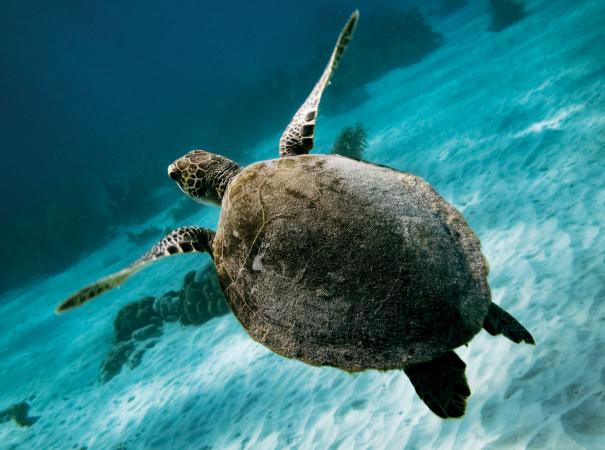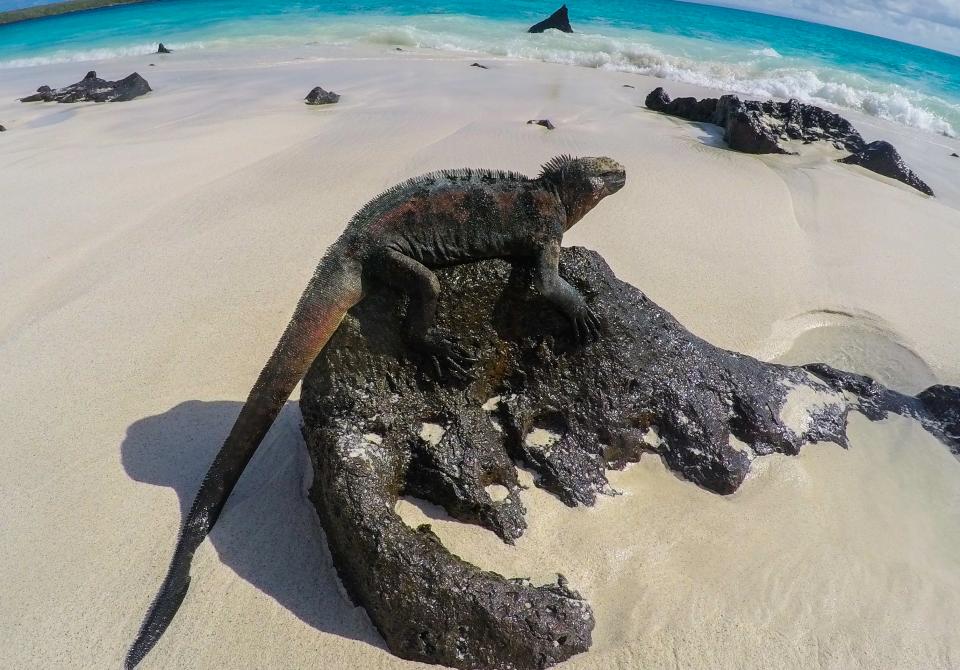The famous Panama Canal (in case you don’t know) is a manmade link between the Atlantic and Pacific, created to save months of sailing a northerly or southerly passage to access the ocean. For the whole fleet, this two-day transit took them 85 feet above sea level through six locks and a total of 48 miles with an overnight stay on the stunning Gatun Lake, which forms a major part of the Canal. This lush lake is peppered with beautiful islets and the occasional crocodile.
Vela, SUNsuSEA and Boysterous were the first of the fleet to head out under the Bridge of Americas and into the Pacific Ocean. It was a thrilling experience, described as a big bucket list item for many. Cheers and whoops of joy heralded the fleet’s arrival in the Pacific and, as Annie from Oyster 45 Vela explained, “it was a very emotional moment passing from the Atlantic to the Pacific”.
The fleet stopped in Panama City to enjoy some retail therapy before heading off to Galápagos Islands, with a quick stop for some in the Las Perlas Archipelago. David Pedley, owner of Oyster 56 Sea Flute described the stretch of water between Panama City and Las Perlas as: “one of the most amazing. The seawater brimming with wildlife, from multitudes of jumping fish, numerous pods of whales and silver rays somersaulting out of the water”. The Las Perlas Islands are fringed with white pristine beaches whilst home to an interior of rainforest.
As the Oyster World Rally fleet sailed across the Equator en-route to the Galápagos some strange sights unfolded.
A time held tradition requires all vessels that cross the Equator must pay their respects to the Lord of the Sea, ‘King Neptune’ and gain his acceptance and a safe passage on the high seas. Overseen by the Court of King Neptune the ‘Shellbacks’ (seasoned sailors who have previously crossed the Equator) carry out an initiation ceremony for the ‘Pollywogs’ (the unseasoned sailors crossing the Equator for the first time).
This can involve everything from head shaving, dosing with seawater to drinking of the truth serum (raw egg yolk and chilli). Neptune presides over the ceremony with his magnificent Trident in hand and adorned with a golden crown, whilst his Queen Amphitrite stands by his side with other members of the court – a motley crowd depending on the imagination of those on board. The court would normally include Davy Jones, a barber, a policeman and possibly a bear. And of course, dressing up is de-rigeur…
After the initiation, the ‘Pollywogs’ officially become ‘Shellbacks’ and they can start planning the initiation for the next batch of ‘Pollywogs’ when the fleet crosses back over the Equator.
"The stretch of water between Panama City and Las Perlas is one of the most amazing. The seawater brimming with wildlife, from multitudes of jumping fish, numerous pods of whales and silver rays somersaulting out of the water”
The Galápagos Islands are an archipelago of volcanic islands distributed on either side of the Equator in the Pacific Ocean. Known for their vast number of endemic species and studied by Charles Darwin during the voyage of the Beagle in 1835, his observations and collections from the islands were at the heart of the ideas behind his theory of evolution by natural selection.
UNESCO recognised the islands in 1978 as a World Heritage Site and in 1985 as a biosphere reserve which was later extended to include the marine reserve. In 1986, the 70,000 km2 of ocean surrounding the islands was declared a marine reserve and four years later the archipelago became a whale sanctuary. Noteworthy species include the Galápagos land and marine iguana, Galápagos tortoise and green turtle, sea cucumber, flightless cormorant, frigatebird, blue-footed booby, Galápagos penguin, waved albatross, Galápagos hawk, four endemic species of Galápagos mockingbirds, thirteen endemic species of tanagers or Darwin’s finches, Galápagos sea lions and two endemic genera of cacti. There is rather a lot to see…
Ninety-five percent of the land area of Galápagos is designated as protected by the Galápagos National Park Directorate and tourists are permitted to explore specific visitor sites only with Park-certified naturalist guides, so most people opted for a visit on a local excursion boat. Some yachts picked up a Naturalist guide to give them custom-made cruises through parts of the protected areas.
Oyster 575 Miss Tiggy described the experience and some of the close encounters with the animals: “Eerily, nothing seemed afraid of us. We walked or swam right up to them and they would just calmly survey us with one eye open or a querying look as if to ask ‘who and why have you ended up in my space’? Imagine walking into a zoo with no fences or swimming in an aquarium made up of lava rocks. The difference here is they are free, and we are the guests in their habitat.”
On 25 April 2017, Oyster 725 On Liberty was the first of the Oyster World Rally fleet to arrive in Nuku Hiva – a beautiful French Polynesian island boasting lush green valleys, dramatic waterfalls and razor-edged basaltic cliffs. On Liberty was soon followed into Taiohae Bay (Nuku Hiva’s capital) by Oyster 66 Elise, Oyster 56 Oregon Native and Oyster 825 Enso. Over the following fortnight, the whole Oyster fleet arrived in the Marquesas Islands having successfully completed the longest ocean crossing of the rally.
In early May the Aranui 5, a cargo/passenger vessel arrived in Taiohae Bay. This iconic ship has supplied the remote islands of the Marquesas for over 30 years. The Oyster fleet received an exclusive invitation to go aboard and meet Pierre Ottino, a locally renowned research lecturer who has spent over 15 years studying the archaeological sites of the Marquesas. Guests were captivated by his presentation on the history of the islands and their culture, showing his works over the years and how these have inspired islanders to embrace their heritage.
A few days later, all the Oyster World Rally skippers were invited to a special briefing from Stephanie Betz from Archipelagos. This covered the passage from the Marquesas to the Tuamotus Islands and beyond. Detailed tide times, local contacts and general advice were given on several of the atolls which the fleet would visit in the coming weeks. The briefing was followed by an afternoon of festivities on the beach and in the gardens around the dockyard. Guests were welcomed by traditional Marquesan dancers, given handmade seed necklaces and a fresh coconut to drink on arrival. The Committee of Tourism in Nuku Hiva arranged for local craftsmen and women to demonstrate their skills, encouraging guests to try making their own baskets or seed necklaces, as well as to taste the locally grown fruits on display. In the evening, everyone enjoyed a full Marquesan dance show to the powerful beat of the bass drum. Particularly captivating was the ‘Bird and Pig’ dance. This incredible performance was followed by a traditional feast of goat, pig and fruits de mer, all cooked in an earth oven. Everyone left with lasting memories of an amazing ‘Welcome to French Polynesia’.
Oyster 54 Talaba summed up their visit to the Marquesas, saying: “The Marquesas are magical - after 3000 nm at sea we arrived in spectacular scenery…we visited Fatu Hiva, Hiva Oa, Tuhuata, Ua Pou and Nuku Hiva and all have so much to offer. The islands are unspoiled, the vegetation is incredible – trees, flowers, and fruits everywhere and the people are so friendly. You cannot pass anyone without greeting and people chat to you along the way…”
With its beautiful bays and diverse aquatic life, the volcanic island of Moorea is one of French Polynesia’s most inspiring destinations. The sparkling turquoise waters contrast with an explosion of green velvet cliffs – this is simply nature at its best.
Getting to this hidden gem is quite a chore for the traditional traveller but for the Oyster World Rally fleet, it was a journey of exploring a sailing paradise. Captain Cook first discovered the magical island 340 years ago. Cook’s Bay, a sheltered anchorage on the north of the island, was the perfect meeting place for the Oyster fleet to rendezvous once more. Tahiti-style celebrations took place over two days and, being the fun-loving group that they were, owners and crew embraced what can only be described as ‘traditional activities’ involving coconuts and bananas…
Swapping their luxury yachts for canoes, the fleet enjoyed an afternoon of racing on the water, followed by a competitive but jovial tug-of-war. Everyone sampled the local delicacies, including Poisson Cru (raw Tuna in coconut milk) and Hinano beer (very alcohol-hic) against the backdrop of dramatic razor-edged mountains. As the sun set, everyone was entertained by traditional fire dancers expressing their power and prowess with flames and movement as the sun set on yet another spectacular day in the world of Oyster, one to be a treasured memory for all.
And for those interested in cultural tradition, Tahiti’s islands have its own equivalent of Tinder – if a flower is worn on your left ear then your heart is taken but if you’re looking for love then you wear it on your right. Who says romance is dead?
There are some treasures in life that are meant to be discovered, experienced and shared. And the island of Nuie has been one of the world’s best kept secrets until now. Visited en-route from Bora Bora to Tonga by the Oyster World Rally fleet, Nuie’s magnificence is certainly worth a mention. Described as one of the smallest countries in the world, and one of the largest raised coral atolls on earth, this little gem captured the hearts of those lucky enough to have visited. Oyster 45 Vela’s Annie Longstaff takes up the story:
“A shaft of light streams through the open cabin hatch, hardly a breath of wind, it’s 4am and the moon is full. A whale sings… We are anchored in 30m of crystal-clear water in Alofi Bay, Nuie, (‘Behold the coconut’) 250 nm east of Tonga. It is migration time for whales with their calves through these calm, tropical calm waters.
“An unremarkable low-lying island from afar, this coastline holds secret treasures, deep chasms, limestone caves with their impressive stalagmites, turquoise lagoons, vertical cliff walls and arches, ancient coral paths wind through dense undergrowth… Unsurpassed beauty.
“The people are lovely too – just 1,700 living simply in square stone and wood houses with tin roofs. They are New Zealand citizens too but choose to live in tranquillity amongst the lush green bush, surrounded by coconut palms and the azure waters of the South Pacific. The churches are simple but large; well- maintained gravestones stand at the roadside or in family gardens and a large population of wild chicken roam free. Life is unhurried and there is a real calm about the place.
“One unusual thing here is that due to the coral plateau near the shore our dingy has to be lifted out by crane (not with us in it I hasten to add!) which requires some careful manoeuvring back into the water after an evening ashore… It is a lovely island that we will remember fondly. “
No doubt the next Oyster World Rally will drop anchor at Nuie and another group of owners will be able to tick it off their bucket lists!
An unremarkable low-lying island from afar, this coastline holds secret treasures, deep chasms, limestone caves with their impressive stalagmites, turquoise lagoons, vertical cliff walls and arches, ancient coral paths wind through dense undergrowth… Unsurpassed beauty.


